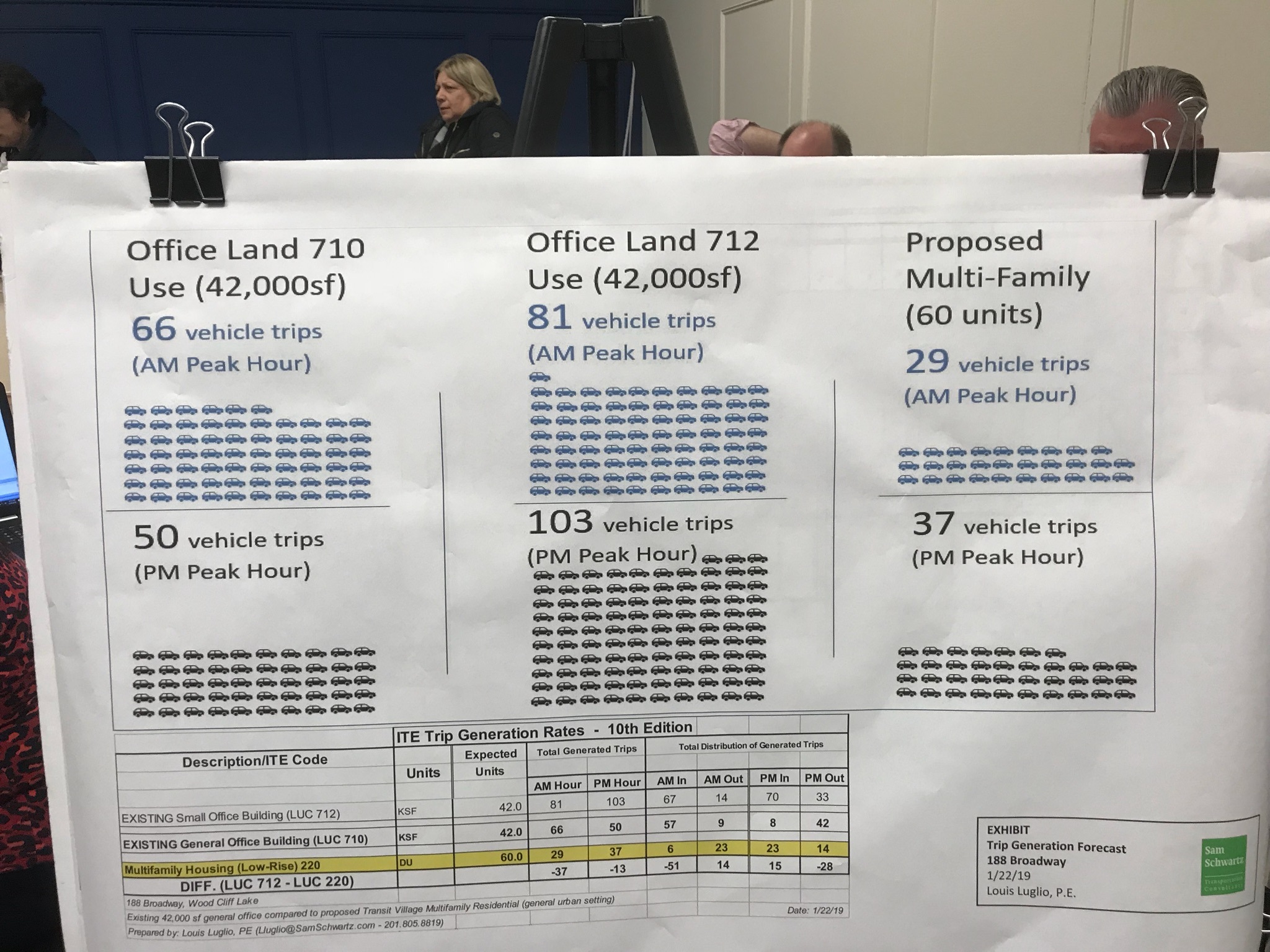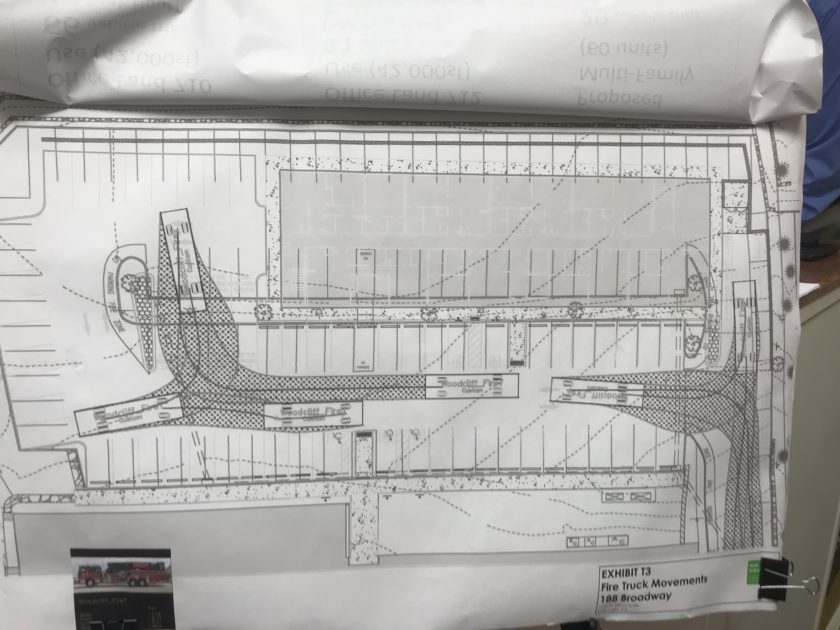
BY MICHAEL OLOHAN
OF PASCACK PRESS
WOODCLIFF LAKE, N.J.—Questions about local and regional traffic impacts from a proposed 60-unit multifamily housing development at 188 Broadway dominated the third Zoning Board hearing held Feb. 26 at Borough Hall.
By the end of a nearly three-hour meeting, only board members had questioned the applicant’s traffic expert. Public comments and questions will be continued at the next hearing, March 26.
In addition, the applicant may present a planner to testify on the proposed complex, which includes nine affordable rental units planned for the site.
A traffic expert testifying for applicant, 188 Broadway LLP, told approximately 20 residents filling the small municipal chamber that there would be “no associated impact” from vehicle traffic generated by the proposed two-building multifamily development and came under intense questioning by board attorney Sal Princiotto and board chair Christina Hembree.
Traffic reduction seen
Louis J. Luglio, an engineer with Sam Schwartz Transportation Consultants, testified that a standard trip-generation traffic model predicted “a reduction in the number of vehicles going to and from the site.”
He cited computer-generated statistics that show reduced traffic into and out of the proposed multifamily development versus its current use as an office building.
Luglio said that peak-hour morning trips, 7–9 a.m., would fall to 29 trips in and out compared to 66 generated by the existing office building; peak-hour evening trips, 4–7 p.m., would decline to 37 from the 50 trips generated by the current office building.
Luglio showed a chart illustrating the ITE trip-generation model results depicting two types of office-related commercial developments compared to the proposed 60-unit multifamily buildings.
He said his calculations did not take into account the proximity of the planned development to a nearby train station, which he said was likely to further reduce trips in and out for the proposed residential use.
“Since we have a (trip) reduction and not an increase there is really no reason to look at additional intersections or the roadway itself,” said Luglio.
Chair Christina Hembree cited two ongoing Park Ridge developments—including an apartment complex on Kinderkamack and one on Park Avenue— likely to impact local traffic along the Broadway corridor, in addition to Montvale’s proposed developments and future developments in nearby towns.
Luglio said the county level was proper for regional traffic planning, not for the current application.
When Hembree pressed Luglio whether the municipality should plan for future traffic conditions, Luglio said that should not be part of the current application.
She said the impact of an increase in traffic along Broadway, Kinderkamack, and Pascack Road should all be considered as part of the application.
Three variances sought
The applicant is seeking three variances: a use variance to put residential housing in a dual office and single-family zone; a three-story building where only 2.5 stories are allowed; and one for less landscaping (185 square feet) in an interior parking lot where 1,320 square feet is required.
Two buildings will be constructed on site: Building One is entirely in the S-O Zone, or Special Office Zone, in front of the site and Building Two will be built where a parking lot stands.
Building One will have 28 one-bedroom and eight two-bedroom units and Building Two will include 18 one-bedroom and six two-bedroom units.
“If this particular project…decreases the number of vehicles there really is no reason to look at other offsite intersections for traffic impacts because there is no associated impact,” said Luglio.
Board attorney Sal Princiotto said the traffic congestion “could be significantly more” with a multifamily development than an “underutilized” office building, a statement that Luglio disagreed with.
However, Luglio said, “We’re not talking about a significant amount of traffic” and though area roadways are congested, “that’s not the test of this particular application and land use.”
When pressed by Hembree about the difficulty of not being able to turn into or out of a new development because of traffic, he said potential residents should be able to get into and out of the site. He suggested consulting with Bergen County engineers to determine whether turns should be restricted into or out of the proposed complex.
‘Look at the big picture’
Hembree said because the applicant was requesting a change of use [zoning] for the property, it needed to “look at the big picture” of traffic in the area.
But Guglio disagreed and said the peak-hour traffic periods are reduced with a residential use versus an office use. Hembree said the board does not want to create a problem “if we don’t have to. I think we have the responsibility to look at the [regional traffic] issue,” she said.
Guglio said the county should be looking at traffic impacts from all the development occurring in the Pascack Valley area. He suggested employing the board’s traffic expert to do a study on possible traffic impacts on local roads.

‘Congestion’ conceded
While Guglio conceded that “there is traffic and there is congestion” and that additional development in surrounding towns will cause more local traffic, the traffic added by a new residential development “wouldn’t significantly change that” and would not require traffic-mitigation measures.
Guglio rebutted board member Gary Newman’s contention that development density could affect traffic generated by the site, saying that 60 units in residential housing generates a specific number of vehicle trips in and out of a site no matter the density.
Guglio said to date he has had no discussions with county officials to discuss traffic at the intersection near the railroad station and possible impacts from a new development.
Board traffic engineer Brian Intindola, of Neglia, said the applicant should provide a trail or sidewalk from the central courtyard to the train station to show the linkage to mass transit.
He said concerns about all increased traffic in Bergen County are evaluated by the county on a periodic basis when traffic counts are taken and that municipalities can contact the county to request a traffic study.
He suggested that Guglio contact the North Jersey Transportation Planning Agency for traffic projections for roads related to the proposed development.
He said the regional agency “may not be aware of” how development changes are affecting North Jersey traffic patterns.
Intindola said Guglio needed to take weekend traffic counts for the next hearing. He said for “transit-friendly use” the applicant may consider a more level grading, easier to walk pedestrian path leading to the light at Highview Avenue to facilitate access to the train station.
At several points during testimony, Guglio spoke about solving issues related to emergency vehicle access, including turning a large vehicle around a corner with parked cars present.
In addition, questions about property access for articulated fire trucks, including aerial ladder trucks that need a wide turn radius, were illustrated by a chart Luglio referenced.
The chart indicated large fire trucks would not make tight turns with cars parked in all available spaces.
He said the fire department was interested to know whether a large fire engine could make a K-turn if vehicles are parked in visitor spaces overnight.
He said that would not be possible but adjustments such as prohibiting overnight parking for certain spaces might occur.
After a discussion of future complex residents being restricted from making a left onto Broadway from the complex and being forced to drive into Park Ridge before turning around, Hembree suggested another option for planning.
Hembree said she agreed with “a suggestion that somebody has the information that all of these communities need to look at information to make more intelligent [planning] decisions.”
Intindola said if the case is made for a regional approach to traffic concerns, then a study might be undertaken for the Broadway corridor by a county or regional planning agency.
‘Get the mayors together’
“So we should get the mayors of these towns to get together and ask for it,” said Hembree, noting that the Sony property in Montvale and Park Ridge is proposed for development “and that you can’t get in and out of easily,” she added.
A tri-borough study in 2010 looked at traffic in Park Ridge, Montvale and Woodcliff Lake and planner Richard Preiss suggested that it might be of interest to all three municipalities to have the study updated.
Following the meeting, representatives from a group opposing the development said that access for fire trucks on site remains a top concern. Hembree said later that she may invite a fire official to the next hearing to answer questions on fire truck access and fire safety issues.
